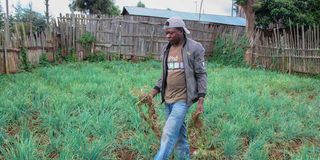Returns on Investment in onions production

Dennis Kasindu, an Elburgon resident, tends to his onions. One earns more with right inputs. John Njoroge | Nation
After every production, it is important for a farmer to evaluate her profits or losses. It is essential to keep detailed records of expenses incurred during onion production to accurately determine profitability of the enterprise.
Farmer Desmond has maintained records since the beginning of production.
This includes fertiliser, chemical and the labour records for the onion production.
Return on investment (ROI) refers to a financial metric used to evaluate efficiency or compare the efficiency of different investments.
It is usually expressed as a percentage and calculated by dividing net profit by the cost of the investment.
This information tells if a specific crop production is worth investing and how it compares against other opportunities.
The ROI for onion production varies, depending on market demand, location, input cost, yield per acre and other factors. Here are general guidelines to help a farmer estimate the ROI.
First, the cost of land preparation, labour, irrigation, seedlings, fertiliser and pesticides can significantly affect the ROI.
It is necessary to budget for these costs and shop around for competitive prices.
Secondly, the average yield of onions per acre is 13 to 20 tonnes, depending on variety and growing conditions.
The higher the yields, the higher the ROI, which also requires more inputs and management.
Thirdly, market fluctuations affect the ROI, hence the need for the farmer to conduct research to determine the current price and potential buyers.
Lastly, the onions should be timely harvested as the ROI depends on the time it takes to harvest and sell the produce.
In most cases, the ROI ranges from 55 to 200 per cent.
A farmer earns more with the right inputs and management practices.
It is important to note that onion production can be challenging and requires careful planning, management and market research to maximise profits.
The cost of production rose by almost Sh8,000 as compared to the budgeted amount due to increased farm input prices.
The ROI is calculated using the following formula:
ROI = (Net Profit / Cost of Investment) x 100.
This shows farmer Desmond made profits on the onion production.
It is worth noting that the cost incurred does not include the cost of infrastructure such as setting up an irrigation system – since this has already been installed – or other fixed costs.
In our next article, we shall look at waste management on the farm after production.





